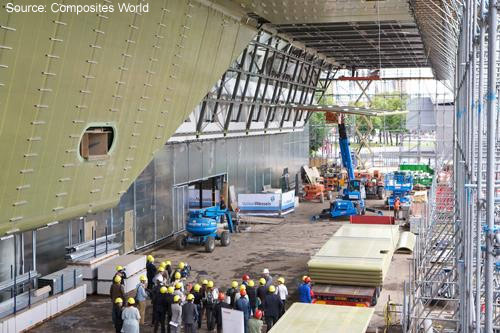Back in July, Teijin announced that their fibers would be used for the installation of massive composite panels on the face of the Stedelijk Museum in Amsterdam, The Netherlands. Using both aramid fiber and carbon fiber, this building is said to be the largest composite building in the world.
Not only did Teijin produce these giant panels, but they are also donating them for the facade of the building along with a substantial contribution for the museum. The buidling itself is designed by BenthemCrouwel Architects and consists of a single surface and covers an area of about 3,000 m2/32,291 ft2. Because of the properties of carbon fiber, a team of experts was needed to brainstorm a solution to minimize thermal expansion of the material as much as possible, in order to obtain a seamless effect.

“An analysis provided by the engineering firm Solico showed that an optimal solution would consist of a sandwich construction. The construction consists of an inner skin and outer skin of a composite laminate of resin, strengthened by Twaron and Tenax fibers. Where the resin expands as the temperature rises, both Twaron and Tenax fibers, due to their negative longitudinal thermal expansion coefficient, behave oppositely. The result is a composite panel with minimal thermal expansion. The composite for the seamless facade of 100m/328 ft expands by only 1mm/0.04 inch per degree Celsius temperature rise. The same facade based on a fiberglass composite or aluminum would expand almost two and a half times as much.”
Like we said, Teijin provided the Twaron (aramid fiber) and Tenax (carbon fiber) fibers to the Holland composites which then produced a fabric as an intermediate product. Holland composites then produced the panels that would be used for the facade of the museum using the fabrics, vinyl ester resin and a foam core. Both the inner and outer skin of the sandwich construction consists of the aramid fiber with carbon fibers in between and are perpendicularly oriented to each other.
At the end of the day, the façade consists of 271 loose elements containing 4,850 kg/10,692 lb of Twaron (aramid fiber) and 4,050 kg/8,929 lb of Tenax (carbon fiber). Wow! That’s a lot of carbon fiber considering how light weight the material is. The panels are mounted on site and glued together using a connecting laminate in order for the façade to form a single unit.
I love that previously we wrote an article about carbon fiber being used in shoes, and now we are sharing information on industrial structures. It just goes to show you, there really is no end to the applications carbon fiber can be used for. To stay updated with the progress of the museum, be sure to check out their website.
[Source: Composites World]